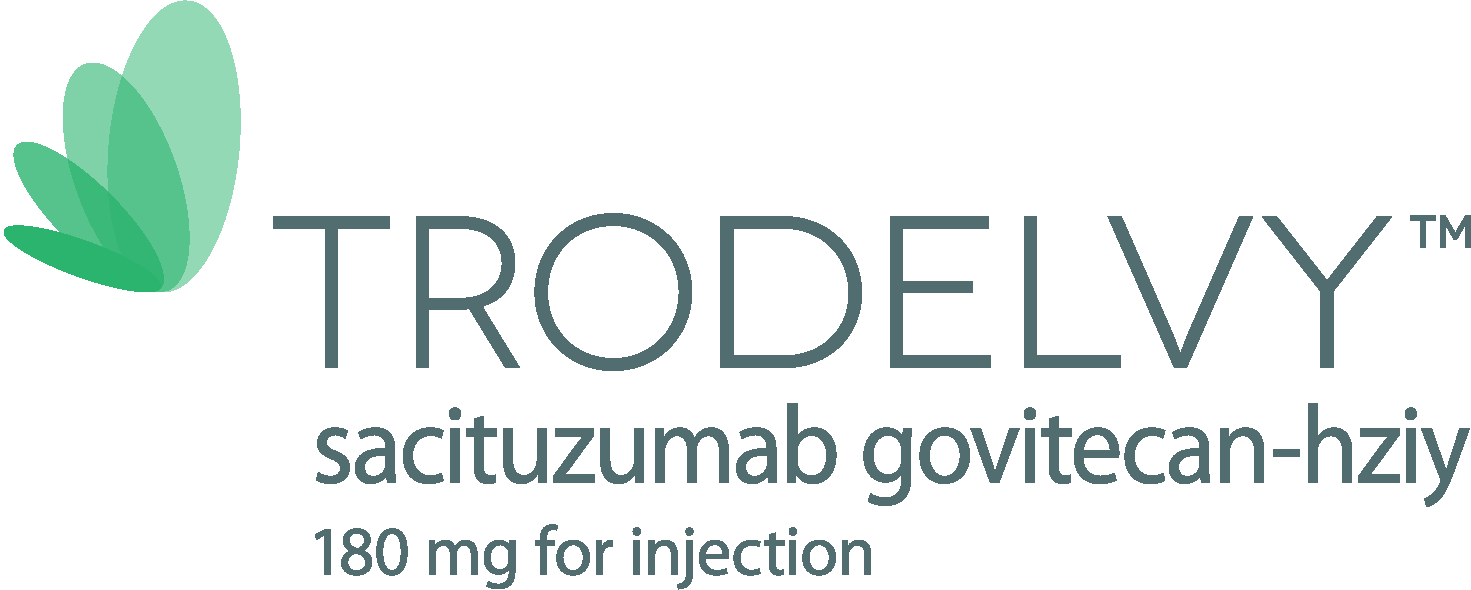INDICATION
TRODELVY (sacituzumab govitecan-hziy) is a Trop-2 directed antibody-drug conjugate indicated for the treatment of adults with metastatic triple-negative breast cancer (mTNBC) who have received at least two prior therapies for metastatic disease.
This indication is approved under accelerated approval based on tumor response rate and duration of response. Continued approval for this indication may be contingent upon verification and description of clinical benefit in confirmatory trials.
IMPORTANT SAFETY INFORMATION
WARNING: NEUTROPENIA AND DIARRHEA
Severe neutropenia may occur. Withhold TRODELVY for absolute neutrophil count below 1500/mm3 or neutropenic fever. Monitor blood cell counts periodically during treatment. Consider G-CSF for secondary prophylaxis. Initiate anti-infective treatment in patients with febrile neutropenia without delay.
Severe diarrhea may occur. Monitor patients with diarrhea and give fluid and electrolytes as needed. Administer atropine, if not contraindicated, for early diarrhea of any severity. At the onset of late diarrhea, evaluate for infectious causes and, if negative, promptly initiate loperamide. If severe diarrhea occurs, withhold TRODELVY until resolved to 1 and reduce subsequent doses.
Contraindications
TRODELVY is contraindicated in patients who have experienced a severe hypersensitivity reaction to TRODELVY.
Hypersensitivity
TRODELVY can cause severe and life-threatening hypersensitivity. Anaphylactic reactions have been observed in clinical trials with TRODELVY.
Hypersensitivity reactions within 24 hours of dosing occurred in 37% (151/408) of patients treated with TRODELVY. Grade 3-4 hypersensitivity occurred in 1% (6/408) of patients treated with TRODELVY. The incidence of hypersensitivity reactions leading to permanent discontinuation of TRODELVY was 1% (3/408).
Pre-infusion medication for patients receiving TRODELVY is recommended. Observe patients closely for infusion-related reactions during each TRODELVY infusion and for at least 30 minutes after completion of each infusion. Medication to treat such reactions, as well as emergency equipment, should be available for immediate use.
Nausea and Vomiting
TRODELVY is moderately emetogenic. Nausea occurred in 69% of patients with mTNBC (n=108) and 69% of all patients treated with TRODELVY (n=408). Grade 3 nausea occurred in 6% (7/108) and 5% of these populations, respectively.
Vomiting occurred in 49% of patients with mTNBC (n=108) and 45% of all patients treated with TRODELVY (n=408). Grade 3-4 vomiting occurred in 6% and 4% of these patients, respectively.
Premedicate with a two or three drug combination regimen (e.g. dexamethasone with either a 5-HT3 receptor antagonist or an NK-1 receptor antagonist as well as other drugs as indicated) for prevention of chemotherapy-induced nausea and vomiting (CINV).
Withhold TRODELVY doses for Grade 3 nausea or Grade 3-4 vomiting at the time of scheduled treatment administration and resume with additional supportive measures when resolved to Grade ≤1.
Additional antiemetics and other supportive measures may also be employed as clinically indicated. All patients should be given take-home medications with clear instructions for prevention and treatment of nausea and vomiting.
Use in Patients with Reduced UGT1A1 Activity
Individuals who are homozygous for the uridine diphosphate-glucuronosyl transferase 1A1 (UGT1A1)*28 allele are at increased risk for neutropenia, and may be at increased risk for other adverse reactions following initiation of TRODELVY treatment.
In 84% (343/408) of patients who received TRODELVY (up to 10 mg/kg on Days 1 and 8 of a 21-day cycle) and had retrospective UGT1A1 genotype results available, the incidence of Grade 4 neutropenia was 26% in patients homozygous for the UGT1A1*28 allele (10/39), 13% in patients heterozygous for the UGT1A1*28 allele (20/155) and 10% in patients homozygous for the wild-type allele (15/149).
Closely monitor patients with reduced UGT1A1 activity for severe neutropenia. The appropriate dose for patients who are homozygous for UGT1A1*28 is not known and should be considered based on individual patient tolerance to treatment
Embryo-Fetal Toxicity
Based on its mechanism of action, TRODELVY can cause teratogenicity and/or embryo-fetal lethality when administered to a pregnant woman. TRODELVY contains a genotoxic component, SN-38, and targets rapidly dividing cells. Verify the pregnancy status of females of reproductive potential prior to the initiation of TRODELVY. Advise pregnant women and females of reproductive potential of the potential risk to a fetus. Advise females of reproductive potential to use effective contraception during treatment with TRODELVY and for 6 months following the last dose. Advise male patients with female partners of reproductive potential to use effective contraception during treatment with TRODELVY and for 3 months after the last dose.
Lactation
Because of the potential for serious adverse reactions in a breastfed child from TRODELVY, advise women not to breastfeed during treatment and for 1 month following the last dose of TRODELVY.
Adverse Reactions
Most common adverse reactions (incidence >25%) in patients with mTNBC are nausea (69%), neutropenia (64%), diarrhea (63%), fatigue (57%), anemia (52%), vomiting (49%), alopecia (38%), constipation (34%), decreased appetite (30%), rash (31%) and abdominal pain (26%).
31Jan2020



